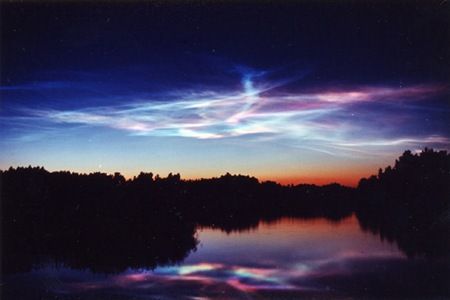
But until recently it was thought that a 33-foot-wide (10-meter-wide) meteor crashing through Earth's upper atmosphere would have little effect.
Now an unlikely team of researchers and a million-to-one observance of such an event are telling another story: When meteors vaporize in our atmosphere, they leave behind much more debris than scientists previously thought.
This cosmic dust may, in turn, affect our planet's atmosphere.
Lidar Luck
Last September, a 33-foot-wide meteor struck Earth's atmosphere. The resulting fireball attracted the attention of a research team at Los Alamos National Laboratory in New Mexico whose primary mission is to detect nuclear explosions.
"It was exciting enough to be able to chart this fireball with the new satellite systems and other detectors that we have in place," said Doug ReVelle, a team leader. "The chances that it fell at that exact location in the [Antarctic] are absolutely astronomical."
"Astronomical" because the meteor fell near researchers from the Australian Antarctic Division.
The scientists were in Antarctica measuring the polar atmosphere with lidar, a laser-based cousin to radar that can determine the composition and density of environments.
The meteor deposited 2.2 million pounds (a thousand metric tons) of debris in the Antarctic sky, forming a vertical cloud high in the zone where the researchers were scanning.
"The readings were so odd that they thought they had an equipment malfunction. But fortunately they kept measuring through it," said Peter Brown, an astrophysicist at the University of Western Ontario in Canada who later helped the team interpret the data.
Realizing that the readings were tied to the same asteroid tracked by researchers at Los Alamos National Laboratory, Brown and other scientists began to study data from Los Alamos and Antarctica.
Where There's Smoke ...
The combination of lidar data and spectroscopic and infrared readings from satellites has given the team enough to work on for years, Brown said.
The researchers have already announced some findings.
In a recent issue of the journal Nature, the team counters one widely held belief: that meteors that vaporize in our atmosphere leave behind particles far too tiny and dispersed to affect the weather.
The researchers say the new lidar readings show otherwise; meteors can leave tons of debris composed of particles at least a micron (one millionth of a meter) across - a diameter big enough to form the heart of raindrops.
The finding means that a strike by a 33-foot (10-meter) meteor could cause minor weather disturbances anywhere winds carry its debris - including the far side of the Earth. (Meteors of that size hit our atmosphere only once a decade, on average.)
ReVelle, the Los Alamos researcher, notes that debris from such a meteor would rain down from the stratosphere and thus could seed clouds.
The scientist notes that meteors won't cause cataclysmic changes in Earth's atmosphere. The total amount of asteroid dust that enters Earth's atmosphere in a year is a small fraction of the total human-made pollutants pumped out in a day.
Comment: They may need to revise that assumption in light of the dramatic increase in meteors, comet fragments and fireballs penetrating our atmosphere in recent years.
Reign of Fire: Meteorites, Wildfires, Planetary Chaos and the Sixth Extinction
Ozone Protection
But the finding does offer a new perspective on how sensitive our atmosphere is.
For instance, a meteor that hits the Earth near the Equator could cause more significant weather effects. Because the sun's energy strikes our planet most directly the Equator, the solar radiation would violently stir any meteor debris deposited there.
The study also suggests that researchers may need to reevaluate the impact of volcanic activity. Volcanoes are capable of jettisoning many thousands of tons of debris into the stratosphere - much more than a meteor and with significantly more energy.
ReVelle spotlights another finding, one that has yet to be published: The team's readings show that the Antarctic meteor may have caused a significant disturbance in the ozone layer.
Scientists thought the protective atmospheric layer in the stratosphere was more impervious to such intruders. The finding, though, suggests the UV-resistant layer may not be as firm a protective coating as believed.
"If you knew about everything that enters our atmosphere every day, you probably wouldn't sleep at night," ReVelle said.



Comment: Cosmic/meteor dust can do far more than affect our weather. See also:
Chemtrails, Disinformation and the Sixth Extinction